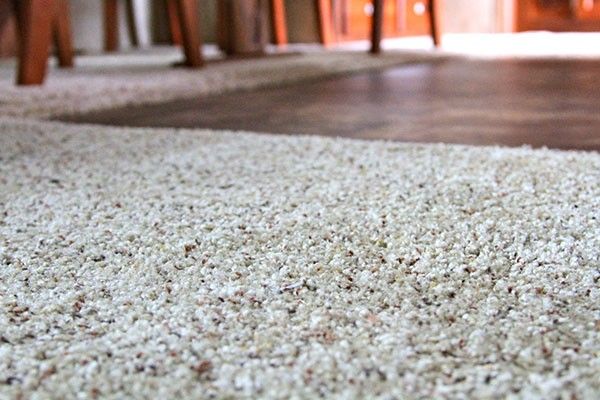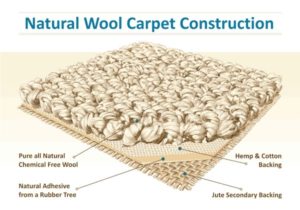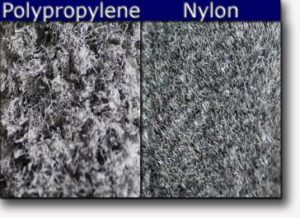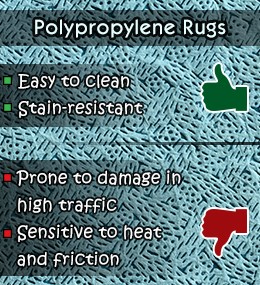What Is Your Carpet Made Of?

When it comes to the carpet floor covering in your home, there are a variety of materials that can be used during the crafting process. Luckily, our Carpet Cleaning professionals know a little bit about these materials. In home carpeting can be made of synthetic or natural fibers. Natural fibers are quite a bit more of a rarity in homes. Carpet made of natural fibers is much more delicate than carpet made of more durable synthetic materials. Natural fiber in home carpet is typically made of wool. Wool can crack, break or shrink if exposed to improper care methods, which typically gives wool a much shorter lifespan than most synthetic materials. In home carpeting can also be made of silk, which is another natural fiber. While it is even more rare than wool, it is a similar circumstance. Silk is a natural fiber that is susceptible to the same wear and tear issues that could negatively affect wool. Synthetic materials are much more commonly used for in home carpeting due to their durability, ease of maintenance and lower costs. The most commonly used synthetic materials for in home carpeting are polyester, polypropylene and nylon. These synthetic fibers are man made and crafted specifically to be durable and cost effective. Since the 20th century, in home carpet manufacturers have mainly been using a variety of these synthetic materials to craft in home carpeting and there are no signs of change on the horizon.
The earliest known origins of people crafting carpeting (typically in the form of what we now know to be area rugs) for use as floor coverings and various other purposes dates back to the 7th century BCE. This has been determined due to evidence of goat and sheep shearing being found in the West Asia area, along with remnants of early rug/carpet craftings. Based on historical evidence, it seems as though the Armenians were the originators of this carpet/rug crafting practice. This has been determined due to the age of the natural fibers found in the carpet, where the carpet was found and the technique used to craft the carpet included the Armenian Double Knot as well as red filamental coloring made from Armenian cochineal. The oldest carpet discovered is called The Pazyryk Carpet. This carpet was unearthed in what seems to be remarkably well condition. The Pazyryk Carpet is dated to be from the 4th – 5th century BCE. Expert historians who have studied this region, it’s people and their practices feel with conviction, that this ancient carpet was used as a funeral accessory. While various colored fibers and what seem to be shreddings of ancient carpets and rugs were found back as far as the 7th century BCE, it is believed that he inhabitants of the Caucasus were weaving amazingly beautiful and colorful rugs for many centuries after.
We previously mentioned that there are a variety of materials that your in home carpet could be made of. Manufacturers use different natural materials and synthetic materials to create in home carpeting to fit the individual needs of consumers. Natural fibered carpet is much less common in homes than synthetic fiber carpet. While the most commonly used natural fiber, Wool, is more durable than you would think, it is not able to withstand as much wear, tear and vigorous cleaning methods as synthetic fibers. Durability and cost make synthetics the preferred option for crafting in home carpet. Here are some of these commonly used carpet fibers and a little bit about each one.
Wool
 For a natural fiber, Wool has pretty good durability. It can be dyed, it is fairly abundant and it is easily accessible. Wool is a textile that is typically obtained from Sheep. Wool can be harvested from other animals such as goats, rabbits or oxen, but those varieties will typically be attached to a different name. Fleece or Cashmere could be used to describe the wool harvested from these other animals. Wool is sheared and processed prior to being used for carpet or rug crafting. Wool will often be blended with a synthetic material to make carpeting. This is to help keep prices low, as wool is much more expensive than synthetic materials.
For a natural fiber, Wool has pretty good durability. It can be dyed, it is fairly abundant and it is easily accessible. Wool is a textile that is typically obtained from Sheep. Wool can be harvested from other animals such as goats, rabbits or oxen, but those varieties will typically be attached to a different name. Fleece or Cashmere could be used to describe the wool harvested from these other animals. Wool is sheared and processed prior to being used for carpet or rug crafting. Wool will often be blended with a synthetic material to make carpeting. This is to help keep prices low, as wool is much more expensive than synthetic materials.
Nylon
Nylon has been the most commonly used synthetic material for crafting carpeting since the 1900’s. Nylon is very durable and can be printed, or created quite easily. It can be dyed, typically during production. Dye is usually added when the Nylon is in its molten state and dried to match the color it is meant to be. Nylon has excellent durability and is widely used in commercial and industrial settings, where carpet is needed. It can hold up well against normal, daily wear and tear, as well as vigorous, heavy duty cleaning processes.

Polypropylene
The main benefit of Polypropylene is its low cost to produce and purchase. This material is most commonly used to construct berber carpets. Polypropylene is often referred to as Olefin. These fibers are made a bit larger than the rest and area looped to create the berber carpet that is best suited for light use. Berber carpet made of Polypropylene, or Olefin, is mostly used in domestic or residential settings as it tends to mat down quickly and does not wear as well as its other synthetic counterparts. There are specialty Polypropylene carpets that can be made to be more durable, but these are basically commercial grade cuts that have very small loops and does not provide much comfort. This type of carpeting is meant only to handle heavy foot traffic and should not be used where appearance and comfort are important. These fibers are difficult to dye as well, which actually helps with stain resistance.
Polyester
 The technical name for Polyester is Polyethylene Terephthalate. Polyester begun to grow extensively in popularity in the early 2000’s, due to the rising costs of most raw materials used to make carpeting. Polyester is typically created at low costs, so it is naturally used in cheaper carpeting. Polyester is hydrophobic, which means it repels water. This makes is quite stain resistant. Similar to Polypropylene and unlike Nylon, the coloring of Polyester takes place when it is in a molten state. This is referred to as solution dyeing. The main disadvantage of Polyester is that it tends to mat or crush easily. Meaning that is it were to be used in a high traffic area or if heavy furniture were to be placed on it for an extended period of time, you could be left with many flattened portions of the carpet that may never fully stand back up. This type of carpeting is best used in low traffic areas.
The technical name for Polyester is Polyethylene Terephthalate. Polyester begun to grow extensively in popularity in the early 2000’s, due to the rising costs of most raw materials used to make carpeting. Polyester is typically created at low costs, so it is naturally used in cheaper carpeting. Polyester is hydrophobic, which means it repels water. This makes is quite stain resistant. Similar to Polypropylene and unlike Nylon, the coloring of Polyester takes place when it is in a molten state. This is referred to as solution dyeing. The main disadvantage of Polyester is that it tends to mat or crush easily. Meaning that is it were to be used in a high traffic area or if heavy furniture were to be placed on it for an extended period of time, you could be left with many flattened portions of the carpet that may never fully stand back up. This type of carpeting is best used in low traffic areas.
In home carpeting has evolved from ceremonial garb, to floor covering rugs, to the standard carpet we see in homes across the planet today. This textile floor covering has become such a common fixture in our lives, that most would not ever realize the historical context of what carpet is and where it came from. Hopefully some of the information in this post is helpful to you. Maybe the next time you kick off your shoes and feel the comfort of that soft, clean carpet on your bare feet, you’ll look down and think about the generations before you who laid the groundwork that made this fine floor covering a standard inclusion in most homes and businesses around the world.

Recent Posts
- Why Like New Carpet Care is the Best Choice for Your Carpet Cleaning Needs
- Transform Your Home with Like New Carpet Care: Your Trusted Choice for Carpet and Upholstery Cleaning
- How the cleaning process works
- The Importance of Choosing a Professional for Carpet Cleaning
- The Importance of Mattress Cleaning
Categories